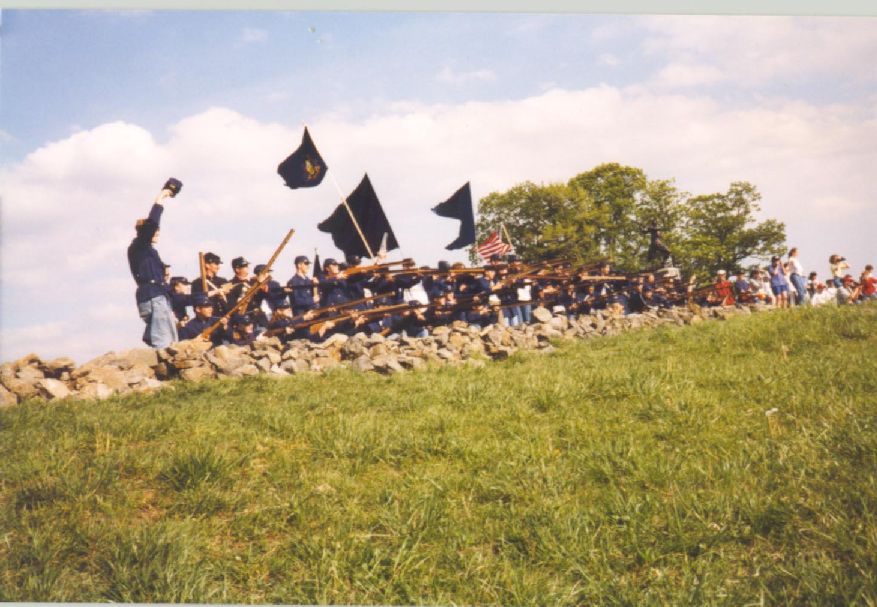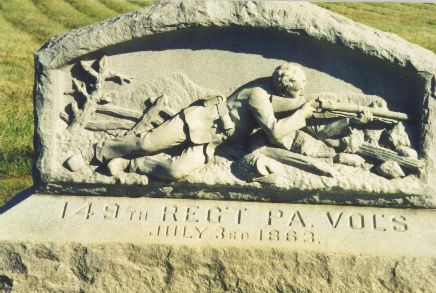
Gettysburg: A brief overview
Written by: Daniel Huang AKA George H. McCahren

The Gettysburg Address (Library of Congress)
****A brief history on the Civil War ****
The Civil War was also called the War Between States. It lasted about four years. Specifically, 1861 to 1865. It was between the federal government of the United States and the eleven southern states that wanted to secede. The Southern states seceded in this order: South Carolina, Mississippi, Florida, Alabama, Georgia, Louisiana, Texas, Virginia, Arkansas, Tennessee, and North Carolina. This took place in 1860 to 1861. It happened because of the culumative friction from several decades over several issues. These issues were about slavery, trade, tariffs, and state's rights. This rose out of diffences between the economies of the Northern and the Southern states. The North had a large growing maneufacturing sector and small farms. They used free labour. The Southern ecnomy was based on plantations which used slave labor. The North wanted to abolish slavery. The South objected and threatened to secede. When Abraham Lincoln of the Anti-Slavery Republican Party was elected president, the South seceded. The South was then organized as the Confederate States of America. They were led by President Jefferson Davis. They depended on patriotic fervour, the strategic advantage of interior lines of communication, and their cash crop: cotton to win a short war of independence. The Northern states of the Federal Union was led by President Abraham Lincoln. The North had twice the population of the South and had greater advantages n manufacturing and transportation capacity. The war began in Charleston, South Carolina. The Confederate forces fired artillery on Fort Sumter (which obviously belonged to the Union) on April 12, 1861. Both sides soon started to raise and organize armies. The war began with Confederate victories. On July 21st, 30,000 Union troops tried to attack the Southern capital of Richmond, Virginia. They were stopped at Manassas and driven back to Washington D. C. The shock of defeat was galvanized the Union. The Union then called for 500,000 more recruits. General George B. McClellan was given the job of training the Union's Army of the Potomac. The leader of the Army of the Potomac was replaced by General Joseph Hooker. Hooker attempted to outflank Southern General Robert E. Lee at Chancellorsville, Virginia but was outmaneuvered and forced to retreat. Both sides had their share of victories and defeats over a long period of time until Gettysburg..... Lee later undertook his second invasion of the North and met resistance which cumulated into the Battle of Gettysburg (July 1-3, 1863). Lee was repulsed by Union General George G. Meade who commanded the defensive positions and fell back into Virginia. Simoutaneously, Union General Ulysses S. Grant captured Vicksburg, Mississippi and the Mississippi River was totally under Union control on July 4, 1863. General William T. Sherman had marched through Georgia in 1864. He also had captured Savannah. Grant also had Lee pinned down in Petersburg, Georgia.

On April 1, 1865, Grant had started his final advance. On April 3, he had captured Richmond, Virginia, the Confederate capital. Lee then surrendered on April 9, at Appomattox Court House. Sherman had then also marched into North Carolina and on April 26, J. E. Jonston had surrendered to Sherman. The Civil War is over.
****Naval Operations****
Naval operations were secondary compared to land operations. David Farragut was hailed for his actions at New Orleans and at Mobile Bay, but there was one famous battle.... The first battle with armored ships also took place during the Civil War. The battle between the ironclads Monitor (Union) and Merrimack (Confederate) on March 9, 1892. It was the first modern naval battle. The largest part of the naval operations was a blockade the Union attempted to stop the Confederacy's commerce with Europe. The blockade was mostly successful.
****Accomplishments****
The North's victory insured the preservation of the Union. Slavery was abolished as well, therefore granting citzenship to the freed slaves. It also allowed the rapidly growing industries in the North to have more power in the urbanized areas in the North.
****Gettysburg****
It was a major engagement fought on July 1, 1863, to July 3, 1863. It was fought 35 (56 km) miles southwest of Harrisburg, Pennsylvania. Gettysburg is considered the turning point of the Civil War. Confederate General Robert E. Lee decided to invade the North to discourage the enemy and to get the Confederacy recognized in other countries. His forces numbered at about 75,000 troops. TheUnion officers, under General George G. Meade, recognized Gettysburg as a strategic road centre and prepared to hold the town until more troops arrived. Both sides decided that Gettysburg was the place to fight on the first day. Both sides ended the day with heavy casulties. On the second day, there were many attacks and counterattacks to capture strategic positions. Such locations were Little Round Top, Cemetery Hill, Devil's Den, the Wheatfield, and the Peach Orchard. Both sides again suffered heavy losses. The third day was when Lee was determined to attack. 15,000 Confederate troops attacked the 10,000 Union troops holding Cemetery Hill. Lee broke through and penertated the ridge but could do no more. Weakened from artillery during the approach, formations hopelessly tangled, and under attack from three sides. This battle was known as "Pickett's Charge." Three brigades of Brigadier General Pickett's division were present at the battle, making up half the attack force. The actual attack was led by General James Longstreet. It was a disasterous failure. On the July 4th, Lee waited for an attack that never came. That night, it rained heavily. Under the cover of rain, he retreated to Virginia.
****Losses at Gettysburg, etc.****
The losses were the war's heaviest. Out of 88,000 Northern troops, their casulties were about 23,000. Out of 75,000 Southern soldiers, 20,000 died. The dedication of the National Cemetery was dedicated by President Abraham Lincoln in 1863. The battlefield became a national military park in 1895.
****Recommended Things to do****
1. Watch "Gettysburg," an excellent movie. Mostly historically accurate (unlike "Titanic"). It was one of the largest reenactments ever.
2. Go visit Gettysburg. It shows you what the place was actually like. Plan to stay more than one day. I guarantee you'll love it!
Daniel Huang can be reached at: vagabond7@juno.com